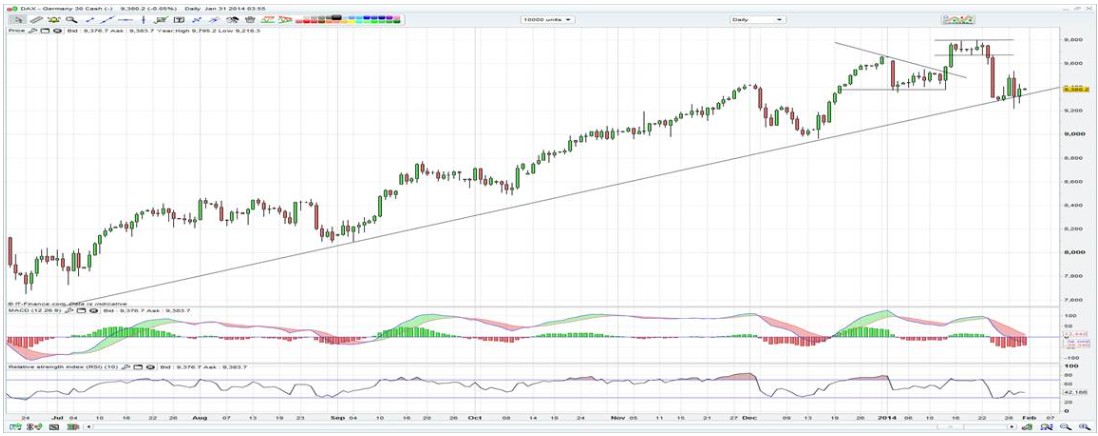
Asian traders were provided a fairly upbeat lead from Europe and the US, although Amazon and Google have gone in differing directions in after-hours trade, ultimately failing to lift S&P futures.
Google closed up 4% after hours, highlighting again what an absolutely brilliant business this is. Ok, you are buying a business that is on a multiple of 18 times 2015 consensus earnings and one that is going to open today at an all-time high, but for me the mantra of buying high and selling higher is the best way to look at a growth-focused, innovator and one-of-a kind business like this. With a stock like Google, you have to throw out the traditional investment rule book of buying low and selling high; think more about momentum.
US leading the way
Growth continues to be a key macro theme the US is showing everyone how to do it. Yesterday’s Q4 GDP figures were strong, especially given the 12.6% drop in government spending. Net exports contributed 1.3 percentage points towards the figure, with exports gaining 11.4% on the year. Certainly it would be have been good to see inflation looking a little rosier, with core PCE unchanged at 1.1%, and this was certainly a reason why the bond market couldn’t find any real upside (in yield).
It’s interesting as well that the Fed fund futures are pricing in 65bp points of hikes from the Fed by December 2015, which is 10 shy of the Fed’s consensus view of 75bp. Clearly we are not seeing the sort of growth or inflation expectations that are causing the market to test the credibility of the Fed’s current forward guidance just yet.
Whilst I’m on the subject of inflation expectations, it’s interesting to look at Japan right now. The bond market (I’ve looked at breakevens – or the difference between the Japanese five-year government bond and five-year treasury inflation protected securities) is giving a massive thumbs up to Abenomics, where over the next five-years the market expects inflation to average 2%, which of course is exactly what BoJ governor Kuroda is trying to achieve.
In trade today we saw the December CPI print increase 10 basis points to 1.3% (ex-food), and we must be seeing signs that the looking sales tax hike is putting upside pressure on prices. It’s interesting though as yesterday’s retail sales report was fairly poor, while data out today showed workers real income fell 2.3% on the year.
We are coming up to a key stage for Abenomics, and as said in previous reports, the combination of rising inflation and stagnant wages is not a good one at all and we are going to need to see more companies raise wages over the coming months.
USD/JPY at the heart of the markets moves
It’s also interesting to see that USD/JPY is really at the heart of moves everywhere right now. Certainly a move in this pair isn’t going to have a direct impact on BHP or RIO for example, however the 30-day correlation USD/JPY has with the S&P 500 cash (and futures) is now at 0.83 (or 83%), which is actually significantly higher than that of the Nikkei. Of course, if the S&P is going up as a result of moves in USD/JPY, then SPI futures will naturally follow and subsequently we get a higher open in the ASX 200 cash. Of course the USD is clearly in play here, but given an unwind of the JPY funded carry trade is a real macro concern, a move higher in the S&P on JPY weakness makes sense.
The Nikkei opened strongly, but pulled back fairly significantly into late trade, although there isn’t an immediate smoking gun. The ASX initially did the total opposite and found good buying from the early low of 5169. With month end in play fund managers will tend to do strange things to portfolios, especially ahead of next week’s earning season ramp up, but we find ourselves with an index that closed down 3% for January. The index seems to be finding good support around the 5160 level, with this being one standard deviation from the 50-day moving average at 5260.
On the forex side the AUD did find some support from the December private sector credit report, which showed a strong 3.9% increase on the year. There is real threat the RBA removes its easing bias at next week’s central bank meeting, however this seems well telegraphed from the market and thus moves in the AUD should be cushioned. Long AUD/NZD has been the trade, although the market has been happy to take profits at 1.0800. I feel the pair trades in a range of 1.0500 to 1.1000 for the year and the lows have been seen. Comments from RBNZ governor Wheeler offered little new information and the market has now fully priced in a rate hike at its next meeting in March.
European markets should get off to a tepid start, with traders watching out for a slew of earnings including MasterCard, Simon Property Group and BT Group. On the data side traders will be keen to look out for French consumer spending, Italian employment, European CPI, Canadian GDP and US personal spending/income. Keep an eye on the DAX, which seems to be holding trend support, just.
(Daily chart of the DAX)
